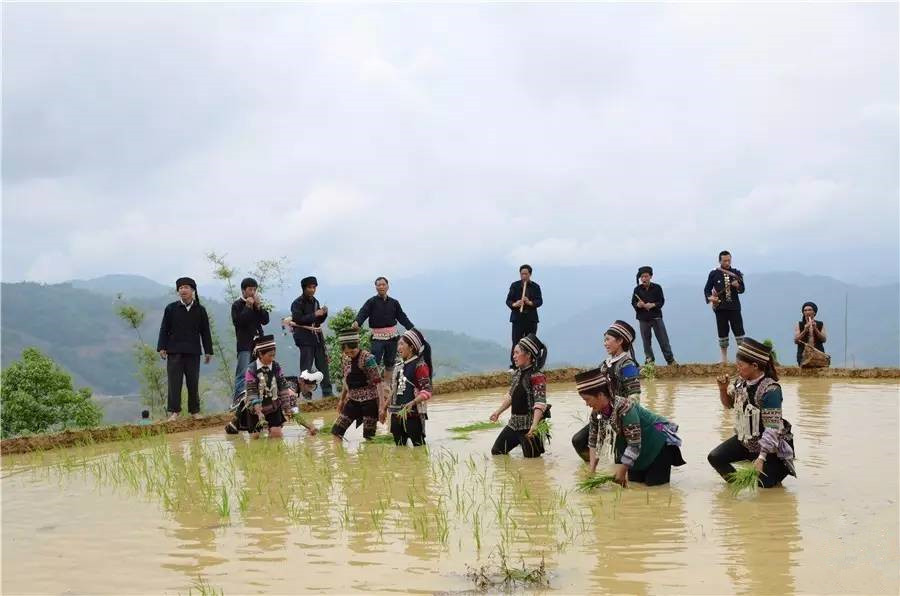
“Transplant Seedling”- Hani Polyphonic Folk Song in Honghe County
The Hani polyphonic folk song Transplant Seedling was circulated in several Hani villages centered in Puchun Village(普春村) in Honghe County, Honghe Hani and Yi Autonomous Prefecture. It is one of the National Intangible Cultural Heritage in Yunnan, which reflects the daily life and cultural of Hani Ethnic Minority.

Brief Introduction
In Hani language, the Transplant Seedling (栽秧山歌) is Wuchuaci (吾处阿茨), which is a representative work of Hani traditional folk song Achi (阿哧). Transplant Seedling is rich in content, including praising labor, love, eulogizing the beauty of the nature. Most of them are directly related to productive labor, especially to terraced fields, rice and seedling cultivation. They can be sung from the beginning of seedling cultivation to the harvest season when paddy turns yellow, that is, from the first month to the “October Year” of the lunar calendar(农历十月年).
Form, Content and Instruments
Singing the Transplant Seedling Song is the most common and lively thing in the planting season. In some places, special singers singing between the terraces to add fun. More often, the women planting seedlings sing extemporaneously while working. All women over 16 in Puchun Village(普春村) can sing. The first form of singing is mainly singing and assisting singing(帮腔), with 7 people in general, 1 leading singer and 6 followers (4 women and 2 men) assisting. If there is a band accompaniment, the lead singer will sing after the the band starts playing. When the lead singer finishes a paragraph, the helper enters the voice part to form the effect of polyphonic voices. The second form includes instrumental accompaniment and non-instrumental accompaniment: the instruments used when singing in the house and on the stage are straight flute(直笛 ,Zhabi in Hani language), small Sanxian(小三弦,Lahe in Hani language), Sanxianxiaoerhu (三弦小二胡(Laheciwo in Hani language)and leaves. In the field, ginger leaves are made into instrument Meipa(梅琶), to make the accompany.
The singing structure of Transplant Seedling Song consists three parts: the opening (开腔), the main singing(主唱) and the assisting singing(帮腔), which formed a singing passage. This passage is also the basis for the singing of the whole ” Transplant Seedling ” , the music passage continues to repeat, while the lyrics are different. During the song, the lead singer is the core, singing the theme and the content. The assisters only sing the auxiliary words, using harmony, multi-part polyphony, to support the lead singer, while the band accompanies. “ The assisters follow the lead singer, the wind instruments follow the men, then the string instruments follow the wind instruments; Singing and playing melodies are different, and change freely with singers; the song is natural, harmonies and leisurely. Up to now, Transplant Seedling Song has 8 voices parts in all, the music is pleasent and beautiful.
Value and Reputation
Transplant Seedling Song has great value for the study of Hani Ethnic Minority’s terrace cultivation culture and its historical origin. It is especially helpful to the understanding of Hani Ethnic Minority’s customs and culture of production and labor all the year round. Since the 1980s, the unique mode and polyphonic singing method of Transplant Seedling has gradually attracted the attention of the outside world. It has successively performed at home and abroad and successfully appeared at the CCTV Western Folk Song TV Competition. The polyphonic music of Hani Ethnic Minority has no strict system of teacher or family transmission, it is mostly taught by oral and memory. At present, there are more than 10 representative inheritors of polyphonic music in Puchun Village, and most young, middle-aged and elderly women in the village can sing it.
Chinese Version: http://www.ynich.cn/view-ml-11110-1233.html
Translated by 杨悦 from College of Foreign Languages of Yunnan Normal University

 7 Days GolfingTour
7 Days GolfingTour
 8 Days Group Tour
8 Days Group Tour
 8 Days Yunnan Tour
8 Days Yunnan Tour
 7 Days Shangri La Hiking
7 Days Shangri La Hiking
 11 Days Yunnan Tour
11 Days Yunnan Tour
 6 Days Yuanyang Terraces
6 Days Yuanyang Terraces
 11 Days Yunnan Tour
11 Days Yunnan Tour
 8 Days South Yunnan
8 Days South Yunnan
 7 Days Tea Tour
7 Days Tea Tour
 8 Days Muslim Tour
8 Days Muslim Tour
 12 Days Self-Driving
12 Days Self-Driving
 4 Days Haba Climbing
4 Days Haba Climbing
 Tiger Leaping Gorge
Tiger Leaping Gorge
 Stone Forest
Stone Forest
 Yunnan-Tibet
Yunnan-Tibet
 Hani Rice Terraces
Hani Rice Terraces
 Kunming
Kunming
 Lijiang
Lijiang
 Shangri-la
Shangri-la
 Dali
Dali
 XishuangBanna
XishuangBanna
 Honghe
Honghe
 Kunming
Kunming
 Lijiang
Lijiang
 Shangri-la
Shangri-la
 Yuanyang Rice Terraces
Yuanyang Rice Terraces
 Nujiang
Nujiang
 XishuangBanna
XishuangBanna
 Spring City Golf
Spring City Golf
 Snow Mountain Golf
Snow Mountain Golf
 Stone Mountain Golf
Stone Mountain Golf













